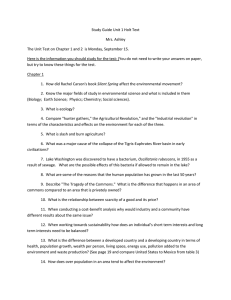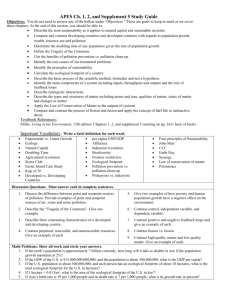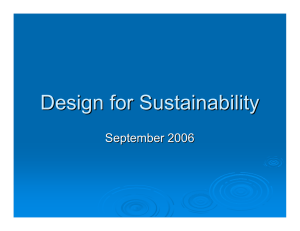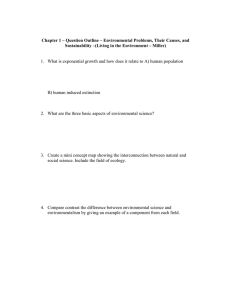Sustainability
advertisement
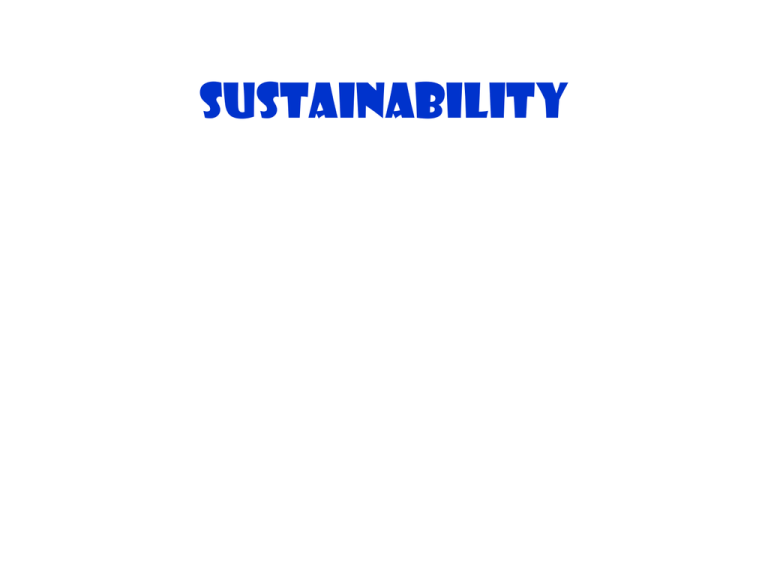
Sustainability ENVIRONMENTAL SCIENCE “Treat the earth well: it was not given to you by your parents, it was loaned to you by your children. We do not inherit the Earth from our Ancestors, we borrow it from our Children. ~ Ancient American Indian Proverb Essential Questions • How the Earth supplies us? • How are we affecting the Earth’s life supports system? Human impact? • How to deal with environmental problems? • What is the most important strategy in Environmental practices? Backpacker’s Motto What do you think is our most serious environmental problem? 1. Corruption in governments and businesses, and bad economic policies 2. Destruction of biodiversity 3. Environmental impacts from human poverty and hunger 4. Genetic engineering of organisms 5. Greenhouse Effect (global warming) and resulting climatic changes 6. Human diseases (cancer, malaria, AIDS, etc.) 7. Human overpopulation 8. Nuclear, chemical and biological weapons of mass destruction 9. Poor farming techniques (soil erosion, overuse of pesticides, livestock wastes, etc.) 10. Wasting of valuable and nonrenewable resources 36% 21% 14% 7% 7% 0% 1 7% 7% 0% 2 3 4 0% 5 6 7 8 9 10 Six important environmental issues • • • • • • Population growth Increasing resource use Global climate change Premature extinction of plants and animals Pollution Poverty LIVING SUSTAINABLY • SOLAR CAPITAL - PROVIDES 99%OF OUR ENERGY WE USE ON EARTH. • EARTH CAPITAL - LIFE-SUPPORT AND ECONOMIC SERVICES. • SUSTAINABILITY - IS THE ABILITY OF A SPECIFIED SYSTEM TO SURVIVE AND FUNCTION OVER A SPECIFIED TIME. SUSTAINABLE RESOURCE HARVEST SUPPLY OF RESOURCES THAT CAN BE HARVESTED EACH YEAR. SUSTAINABLE EARTH • EARTH CAPITAL ARE USED AND MAINTAINED OVER TIME. What is sustainability? 1. Satisfying basic needs without depleting or degrading resources 2. Maximizing resource use 3. Reducing resource use even if it means some big sacrifices by human beings 4. Halting further resource use and limiting human progress 90% 10% 0% 1 2 3 0% 4 SUSTAINABLE SOCIETY MANAGES ITS ECONOMY AND POPULATION SIZE WITHOUT EXCEEDING ALL OR PART OF THE PLANET’S ABILITY TO ABSORB ENVIRONMENTAL INSULTS, REPLENISH ITS RESOURCES, AND SUSTAIN HUMAN AND OTHER FORMS OF LIFE OVER A SPECIFIED PERIOD. HUNDREDS OF YEARS. CARRYING CAPACITY IS THE MAXIMUM NUMBER OF ORGANISMS A LOCAL,REGIONAL,OR GLOBAL ENVIRONMENT CAN SUPPORT OVER A SPECIFIED PERIOD. CARRYING CAPACITY 1. VARIES BY LOCATION 2. GLOBAL CHANGES 3. TYPES OF TECHNOLOGY USES TO EXTRACT AND PROCESS THE RESOURCES LINEAR POPULATION GROWTH • IS A QUANTITY THAT INCREASES AT A CONSTANT AMOUNT PER UNIT OF TIME. • IF PLOTTED ON A GRAPH IT WOULD BE A STRAIGHT LINE. World Population Reached 1 billion in 1804 2 billion in 1927 (123 years later) 3 billion in 1960 (33 years later) 4 billion in 1974 (14 years later) 5 billion in 1987 (13 years later) 6 billion in 1999 (12 years later) World Population May Reach 7 billion in 2013 (14 years later) 8 billion in 2028 (15 years later) 9 billion in 2050 (22 years later) Figure 1-2 Page 4 Slide 2 http://www.ibiblio.org/lunarbin/worldpop The earth’s population is currently 6.6 billion people. The rate of population growth is 1.2 percent. How large will the earth’s population be after 58 years? 33% 1. 2. 3. 33% 33% 10.2 billion people 12.6 billion people 13.2 billion people 1 2 3 Which of the following would not be an example of sound science? 1. 2. 3. 4. Calculating the destruction of trees in a forest based on historical cut rates Calculating the pollution in a stream based on chemical analysis Developing a plan on how to conserve resources based on opinion polls Forecasting CO2 levels in a region based on historical emissions 25% 1 25% 2 25% 3 25% 4 Because developing nations make up 81% of the world’s population, they generate most of the pollution and waste as well as using most of the world’s resources. 50% 50% 1. True 2. False 1 2 How many people live on the earth? 25% 1. 2. 3. 4. 25% 25% 25% About 5 million About 2 billion Over 6 billion Over 10 billion 1 2 3 4 Most population growth is projected to occur in: 50% 50% 1. Developed countries 2. Developing countries 1 2 RESOURCES Nonrenewable resources: 25% 25% 25% 25% 1. Are fixed in quantity 2. Include solar energy 3. Degrade quickly once they have been extracted from the earth 4. Can be exhausted completely 1 2 3 4 WHAT IS SUSTAINABLE DEVELOPMENT? • IS THE CURRENT GROWTH RATE SUSTAINABLE IN THE FUTURE? • THIS IDEA ASSUMES THAT WE HAVE THE RIGHT TO USE THE EARTH’S RESOURCES AND EARTH CAPITAL TO MEET OUR NEEDS BUT THAT WE HAVE THE OBLIGATION TO PASS ON THE EARTH’S RESOURCES AND SERVICES TO FUTURE LEAVE FUTURE GENERATIONS IN AS GOOD OR BETTER SHAPE THAN THESE CONDITIONS WERE PASSED ON TO US. • SHOULD WE LIVE FOR TODAY AND NOT CARE ABOUT HOW FUTURE WILL BE AFFECTED? ECOLOGICAL VS. ECONOMIC RESOURCES • ECOLOGICAL RESOURCE - IS ANYTHING REQUIRED BY AN ORGANISM FOR NORMAL MAINTENANCE, GROWTH, AND PRODUCTION. • ECONOMIC RESOURCE - IS ANYTHING OBTAINED FROM THE ENVIRONMENT TO MEET HUMAN NEEDS AND WANTS. RENEWABLE RESOURCES • RENEWABLE RESOURCES - SOLAR. • POTENTIALLY RENEWABLE RESOURCES CAN BE REPLENISHED FAIRLY RAPIDLY THROUGH NATURAL PROCESSES. • BIODIVERSITY GENETIC DIVERSITY SPECIES DIVERSITY ECOLOGICAL DIVERSITY VARIETY PROVIDES MORE RESOURCES. The ecological footprint is a measure of human demand on the Earth's ecosytems, the amount of natural capital used each year. The footprint of a region can be contrasted with the natural resources it generates. A measure of sustainability the impact of human activities measured in terms of the area of biologically productive land and water required to produce the goods consumed and to assimilate the wastes generated. More simply, it is the amount of the environment necessary to produce the goods and services necessary to support a particular lifestyle. Which of the following countries has the highest ecological footprint per capita? 25% 1. 2. 3. 4. 25% 25% 25% India The Netherlands The United States All are about the same 1 2 3 4 Per Capita Ecological Footprint (Hectares of land per person) Country 10.9 United States 5.9 The Netherlands India 1.0 Figure 1-8 (1) Page 10 Slide 8 Country Total Ecological Footprint (Hectares) 3 billion hectares United States The Netherlands India 94 million hectares 1 billion hectares Figure 1-8 (2) Page 10 Slide 9 The Global Footprint Network estimated the global ecological footprint as "1.5 planet Earths"; that is, they judged that ecological services were being used 1.5 times as quickly as they were being renewed Cities, due to population concentration, have large ecological footprints and have become ground zero for footprint reduction. Some Major Problems Fig. 1–13a © Brooks/Cole Publishing Company / ITP More Major Problems Fig. 1–13b © Brooks/Cole Publishing Company / ITP Still More Major Problems Fig. 1–13c © Brooks/Cole Publishing Company / ITP QuickTime™ and a Photo CD Decompressor are needed to use this picture QuickTime™ and a Photo CD Decompressor THE TRAGEDY OF THE COMMONS. are needed to use this picture “ IF I DO NOT USE THIS RESOURCE, SOMEONE ELSE WILL. THE LITTLE BIT I USE OR POLLUTE IS NOT ENOUGH TO MATTER.” WITH ONLY A FEW USES, THIS LOGIC WORKS. HOWEVER, THE CUMULATIVE EFFECT OF MANY PEOPLE TRYING TO EXHAUSTS OR RUINS IT. THEN NO ONE CAN BENEFIT FROM IT, AND THEREIN LIES THE TRAGEDY. QuickTime™ and a Photo CD Decompressor POSSIBLE SOLUTIONS are needed to use this picture •USE THE COMMON-PROPERTY RESOURCE AT RATES BELOW WHAT IS SUSTAINABLE BY REDUCING POPULATION AND REGULATING ACCESS. PROBLEMS • CONVERT THE COMMON-PROPERTY TO PRIVATE OWNERSHIP. PROBLEMS • COMMAND-AND-CONTROL IS THE USE OF TAXES AND THE FREEMARKET PROBLEMS - What is the tragedy of the commons? 1. 2. 3. 4. The depletion of nonrenewable resources The degradation of renewable free-access resources The seizing of natural resources by government The underuse of resources that could benefit needy people 25% 1 25% 2 25% 3 25% 4 1-4 POLLUTION Is the introduction of any substance into the natural environment that cause adverse change or harm to the environment Sometimes referred to as contaminants POINT SOURCE - COMES FROM A SINGLE, IDENTIFIABLE SOURCE. NONPOINT SOURCE – RUNOFF THREE FACTORS DETERMINED HOW SEVERE THE HARMFUL EFFECTS OF A POLLUTANT ARE. 1. THE CONCENTRATION LEVEL. ppm ppt 2. CHEMICAL NATURE. How active and harmful it is in nature? 3. HALF LIFE OR THE PERSISTENCE OF THE POLLUTANT. ex BIODEGRADABLE DDT IS AN EXAMPLE OF A PERSISTENT POLLUTANT. SOLUTIONS TO POLLUTIONS • POLLUTION CONTROL-INPUT CONTROL THREE Rs • POLLUTION PREVENTION- OUTPUT CONTROL 1. TEMPORARY BANDAGE. 2. THE CLEANUP OF ONE TYPE OF POLLUTANT MAY CAUSE ANOTHER TYPE OF POLLUTION PROBLEM. 3. COST IS 2 HIGH. ONLY 1 % IS SPENT ON PREVENTION 1-5 ENVIRONMENTAL AND RESOURCE PROBLEMS: CAUSE AND CONNECTIONS • RAPID POPULATION GROWTH • RAPID AND WASTEFUL USE OF RESOURCES WITH 2 LITTLE EMPHASIS ON POLLUTION PREVENTION AND WASTE REDUCTION •POVERTY • FAILURE OF POLICIES THAT ENCOURAGE SUSTAINABLE GROWTH QuickTime™ and a Photo CD Decompressor are needed to use this picture Population X Affluence X Technology = Impact IMPORTANT QuickTime™ and a Photo CD Decompressor are needed to use this picture 1-6 Is our present course sustainable Are things getting better or worse? 1-8 ENVIRONMENTAL WORLD VIEWS AND SUSTAINABILITY WHAT’S THE USE OF A HOUSE IF YOU DON’T HAVE A DECENT PLANET TO PUT IT ON? THOREAU • ENVIRONMENTAL WORLD VIEWS • PLANETARY MANAGEMENT WORLDVIEW. SUSTAINABILITY – PLANETARY MANAGEMENT WORLDVIEW WE ARE THE BEST • THERE IS ALWAYS MORE • ALL EC. GROWTH IS GOOD • SUCCESS = CONTROL OF EARTH FOR OUR BENEFIT Environmental wisdom view • Nature exist for all • There is not always more • Some economic growth is good while some might effect the environment “This Earth’s is only on loan to us… One day we must return it to our children.” Working Toward Sustainability Some Guidelines • Leave the earth as good or better than we found it. • Take no more than we need. • Try not to harm life, air, water, soil. • Protect biodiversity. • Help maintain Earth's capacity for self repair. • Don't use potentially renewable resources faster than they are replenished. • Don't waste resources. • Don't release pollutants faster than Earth's natural processes can dilute or degrade them. • Slow the rate of population growth. • Reduce poverty. © Brooks/Cole Publishing Company / ITP
